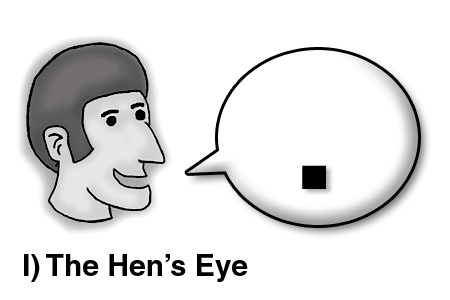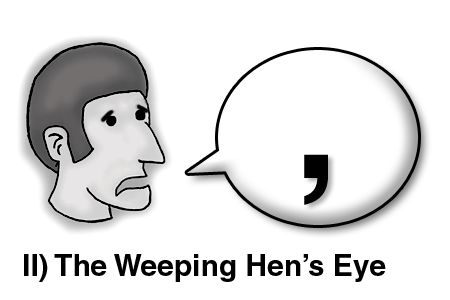This article is part of the Today We Learn English! series.
Our English, when spoken by the sayer and apprehended by he that hears him, is a thing rather more fozy and liquescent than itself as written and read. While heretofore this text has been troubled with the concerns of English as she speaks-- formally named "grammar"--we will now turn our giant book eye to the nature of English as she wrote: "syntax." Make note of the difference by speaking this preceding segment of text aloud, then reading it again inside your head. See how?
An inseparable element of writing, as we know in our own language by our system of trotmarks and clenchmarks, is how we punctuate it. English is no different, regarding this. Many authors of the English language choose to punctuate their work to show the character of their persons, or to add heft to their descriptions. Observe below to apprehend the same text, both with and without, and judge ye which is better:
But without punctuation:
The dog was pensive like an old philosopher and tends to wear corduroy
And with it:
The dog was pensive like an old philosopher... and tends to wear corduroy!
Do you see? No author would be satisfied with his arsenal if absented punctuation, and nor shall you. But what is it? Now we will know. Read on to find out about it.

The unit most basic of punctuation is The Hen's Eye, the smallest among all punctutes and maybe the most versatile. Without it, no sentence could ever be satisfied, and it would meander on into the night like a coach to noplace. The Hen's Eye, known also as a Step, a Foot or a Toad, draws a powerful sense of finality to the sentence before it.
The trick to manning its deployment is to ask this to yourself: would this sentence be further improved by more words, or is it time to stop the words and declare the sentence complete forever? Arrive not lightly upon your conclusion, because once a Hen's Eye is in place, it cannot be undone except with special declaration by your district's Superiors. These declarations are awarded annually to select petitioners.
Exercise: Find where to put The Hen's Eyes in the following units:
a) Dorroile was a pensive man, and tends to wear corduroy
b) Mary felt physically defeated after eating the whole clamcake
c) Arthur, I never said to put it all in that part of you
Are you reeling? But don't, because the answer is below, downward.

Please turn the book over to continue now.

A tremulous cousin to the previous Hen's Eye, The Weeping Hen's Eye is racked with doubts and uncertainties. It is crippled by its hesitation, like the famous English figure Hamlet, or, in our own language, the great analogous hero Clough-Ber-Walf.
Much the same as these two, those who must use The Weeping Hen's Eye are unsure how to proceed. Is our sentence over, or has it just begun? If we pause for a moment, will we be poisoned by ghosts, like Hamlet, or thrust from a speeding van, like Clough-Ber-Walf? We never know, but in these situations, The Weeping Hen's Eye may be our one last final chance to collect our bearings.
Be warned: use of The Weeping Hen's Eye is considered widely, among writers, a sign of personal weakness and timitude.
Exercise: The Weeping Hen's Eye is deployed... justly, or wrongly?
a) I feel like Father expects me to wash myself, but under the circumstances, dare I?
b) I must not hesitate, because I love to GSD ("Get Stuff Done!").
c) Mary, I love you, I want to figure out what coitus is.
Now, find out:

This Week on Something Awful...

Pardon Our Dust
Something Awful is in the process of changing hands to a new owner. In the meantime we're pausing all updates and halting production on our propaganda comic partnership with Northrop Grumman.

DEAR FURRIES: WE WERE WRONG
Dear god this was an embarrassment to not only this site, but to all mankind

Let's improve landmarks
Landmarks and statues around the world: old, boring and could use an update.

Make Horror Wholesome
Join the SA Forum photoshop goons in their quest to make horror wholesome!

Every Conceivable Way EA Could Screw Up Star Wars: Squadrons
Yes, there are finally enough games for a new round of One Sentence Reviews
About This Column
The Something Awful front page news tackles anything both off and on the Internet. Mostly "on" though, as we're all incredible nerds.
Previous Articles
- Keith's Tie Emporium Breakout Deals
- Ancient Greece Express
- Dudes Who Need Ninjitsu Moves Done on Them
- Reading Time: The Calcutta Affair
- My Own Worst Anime
Suggested Articles
About this series
Other articles in this series
- 1. Today We Learn English! Lesson 8: The Tenses
- 2. Today We Learn English! Lesson Thirteen: The Peculiarities
- 3. Today We Learn English! Lesson 4: The Parts of Speech
- 4. Today We Learn English! Lesson 2: The Punctuation